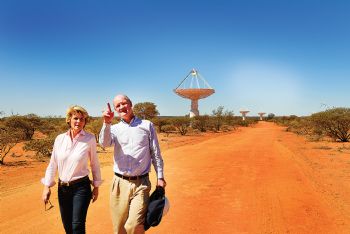
#engineering #mfg #science @essneutron #astrophysics Two large-scale investments worth a total of £265 million, were announced last week by Universities and Science Minister David Willetts at the Jodrell Bank observatory in Cheshire.
The first of these is the Square Kilometre Array (SKA), which will be the largest radio telescope facility in the world, with receivers spread across Africa and Australia. Mr Willetts (pictured with the Australian MP Julie Bishop) said that this £100 million investment could lead to faster smart-phones and increased Internet speeds across the UK.
The second project is the European Spallation Source (ESS), which will be the world’s largest and most powerful microscope, enabling UK scientists to work at the cutting edge of a broad range of science disciplines underpinned by material science, including designing computing chips, batteries and pharmaceuticals, as well as complementing the existing ISIS unit — a world-leading centre for research in the physical and life sciences at the STFC Rutherford Appleton Laboratory in Harwell, near Oxford.
A total of £165 million has been invested in the ESS, which will be based at Lund in Sweden, with construction starting this summer.
Mr Willetts said: “Investment in science is a crucial part of this Government’s long-term economic plan. It is about investing in our future, helping grow new industries and creating more jobs — and that will mean more financial security for people across the country.
“Visionary science projects such as the SKA and the ESS can help to attract and develop the skilled and technically educated workforce the UK needs, while giving UK scientists access to cutting-edge national and international research facilities.”
Both of these projects will be managed by the Science and Technology Facilities Council. Its chief executive, Professor John Womersley, said: “Today’s investment ‘opens the door’ to UK participation in one of Europe’s highest-priority science facilities. The combination of ESS and ISIS will ensure that the UK’s world-leading neutron community continues to have access to be best facilities in the world.”